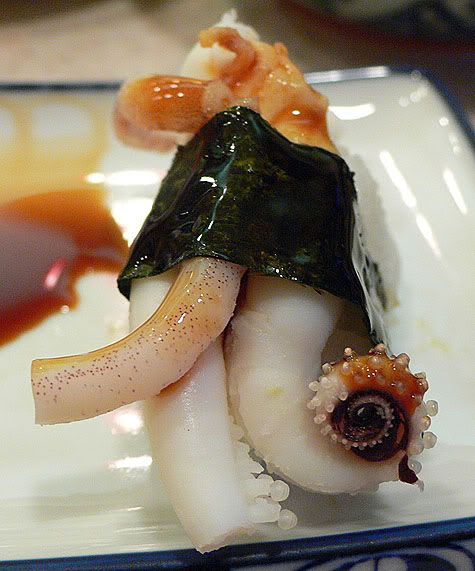
This is what researchers Julian Finn, Tom Tregenza, Mark Norman have reported in a paper published today in PLoS ONE. The researchers--in SCUBA gear--positioned themselves in dolphin feeding grounds near Whyalla, Spencer Gulf and caught the feeding behavior with an HD video camera. They observed how the dolphins corralled the cuttlefish out into the open, pinned them to the ground, hammered them to death, shook the ink out of them, scraped them on the bottom to remove the cuttlebone, and finally bon appétite.

(clicking on image takes you to the full Fig. 1 image at PLoS ONE)
Here's how the researchers describe the steps involved:
- Prey positioning: Cuttlefish prey were typically hiding amongst dense brown algae. On encountering the cuttlefish, the dolphin flushed the prey away from algal cover into areas of open sand (Fig. 1a).
- Prey restraint: The dolphin then adopted a vertical position in the water column and pinned the prey down against the sand substrate.
- Pinned thrust kill: A rapid downward vertical thrust was effected by the dolphin using a powerful tail beat (Fig. 1b, 2a), accompanied by a whole body twist that broke the cuttlebone and/or cephalic cartilage (with a loud click audible to divers), instantly killing the cuttlefish.
- ‘Snout beating’ of the corpse: The corpse was then lifted into the water column on top of the beak (Fig. 1c, 2b) and repeatedly hit with the snout (up to 6 times), until dense clouds of ink were released (Fig. 1d, 2c). Beating continued until ink release diminished.
- Removal of intact cuttlebone: The dead prey was then returned to the sand where it was inverted and the dorsal surface of the cuttlefish body forcibly pushed into and along the sand substrate (Fig. 1e), thus scraping off the thin dorsal skin of the cuttlefish and releasing the cuttlebone, which then floated to the surface.
- Ingestion: The prepared cuttlefish was then consumed whole (Fig. 1f, 2d), or when the head and body were separated during beak beating, only the head was consumed (with attached digestive tract organs).

(clicking on image takes you to the full Fig. 2 image at PLoS ONE)
Naturally there are still questions to be answered. Two important ones are (1) Is this practice widespread or just limited to the dolphins observed? and (2) If it's widespread, is it inherited behavior or passed on culturally? The evidence seems to suggest that the practice is indeed widespread.
Repeated above-water observations of clean cuttlebones bobbing to the surface in association with passing pods of dolphins suggest that some or all of this behavioural sequence is not restricted to a single individual dolphin.
Whether the behavior is taught or inherited is still up in the air (or down in the water) and will require more research.
EDIT: This post is my very first Blogging Peer Reviewed Research post (Did you catch the nifty icon?). So as the total n00b that I am, I did things backwards: I wrote and published the post, then checked the guidelines to make sure that it conformed. You can imagine how aghast I was when I read this.
7. The post should contain original work by the post author -- while some quoting of others is acceptable, the majority of the post should be the author's own work.
A quick perusal confirmed that my post was closer to 50/50 than "the majority of the post being my own work." While I had a high degree of confidence that--as a first timer--they would let me slide, the prudent action is to add more of my thoughts.
It has long been known that dolphins can perform intricate tasks. It has been demonstrated that they can solve problems (such as navigating mazes) as well as perform stunts which they have been trained to do. This particular behavior can be broken into six distinct steps, most of which are each themselves intricate. Given the complexity of the behavior as well as what we know about dolphins, I feel pretty safe ruling out instinctual behavior. More research needs to be done of course.
An observation which I believe would support this hypothesis is if we found the behavior widespread among groups of dolphins who intermingle, but lacking in other groups of the same species who aren't in contact with the group who we prepares cuttlefish this way.
This brings up a question #3 for me. Is this behavior passed on by "passive" imitation or by active teaching? This is the question that I would really like an answer too. I've blogged in the past about how I think that the combination teaching and blind imitation is the root of human culture. In other words, despite my skeptic inclinations to "think for myself" and not just do as I'm told, it takes less energy and time to fill our huge cerebrums with knowledge if just soak up what we're taught than if we try to figure everything out ourselves. And that only works efficiently in a culture if we're also actively teaching what we know to others in our group.
But back to the dolphins, I just don't know-and this paper has only intensified my curiosity. I can't imagine that dolphins teach their young the way we (and apparently there's evidence that some other primates, such as japanese macaques, also) do. Anyway, hopefully now I'm within the required guidelines.
Julian Finn, Tom Tregenza, Mark Norman (2009). Preparing the Perfect Cuttlefish Meal: Complex Prey Handling by Dolphins PLoS ONE, 4 (1) DOI: 10.1371/journal.pone.0004217


3 comments:
http://digitalcuttlefish.blogspot.com/2009/01/perfect-cuttlefish-meal-or-perhaps-not.html
I think that complex behavior learning like this is fascinating, too. And you didn't have a word in there about "melatonin." :)
@Mike:
I didn't know the difference myself until I heard that people were taking melatonin supplements for jet lag. I thought to myself "That can't be the skin pigment!"
:-)
Post a Comment